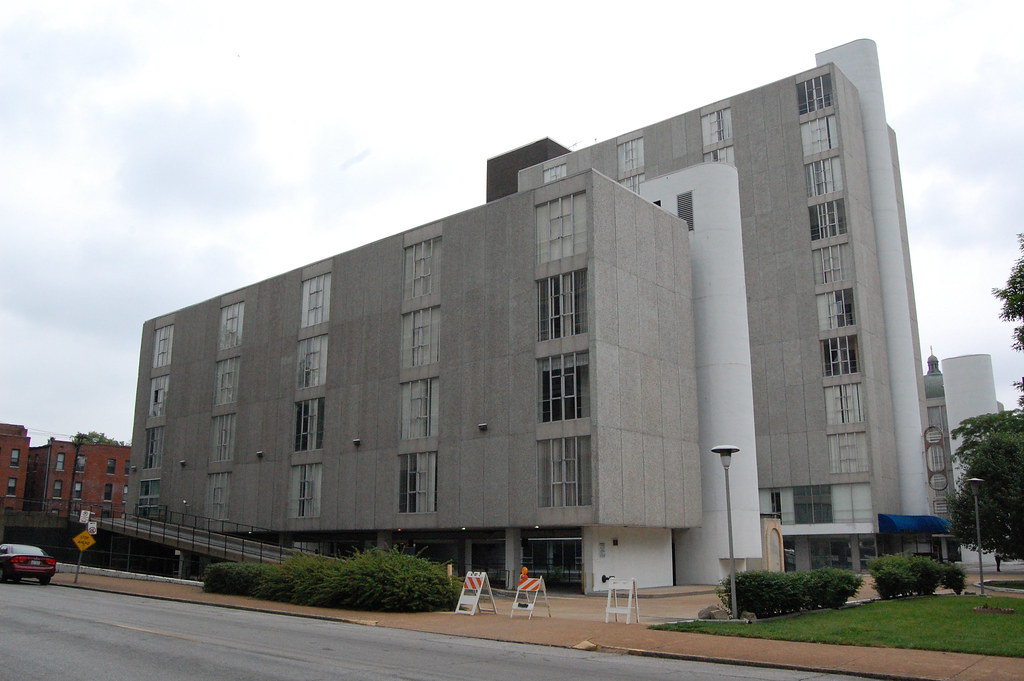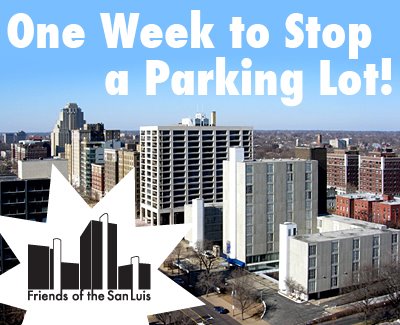 Architect Charles Colbert imparted to the DeVille Motor Hotel the geometric exuberance of the most interesting American modernism. There are many fine modern buildings on Lindell Boulevard that are derivative of the International Style, but there are a few truly original compositions. The DeVille is one of them.
Architect Charles Colbert imparted to the DeVille Motor Hotel the geometric exuberance of the most interesting American modernism. There are many fine modern buildings on Lindell Boulevard that are derivative of the International Style, but there are a few truly original compositions. The DeVille is one of them.
Category: DeVille Motor Hotel
 Cultural Resources Office Director Kathleen Shea has now posted her recommendation to the Preservation Board for the demolition of the former DeVille Motor Hotel and its replacement by a parking lot. Shea seems ambivalent about the Archdiocese’s proposal. Meanwhile, opposition to the demolition grows.
Cultural Resources Office Director Kathleen Shea has now posted her recommendation to the Preservation Board for the demolition of the former DeVille Motor Hotel and its replacement by a parking lot. Shea seems ambivalent about the Archdiocese’s proposal. Meanwhile, opposition to the demolition grows.
Since the DeVille’s architect was Charles Colbert of New Orleans, the New Orleans architectural community is stirred up. The Board of Directors of the New Orleans chapter of the American Institute of Architects sent a plea to the St. Louis Preservation Board. The National Trust for Historic Preservation is also opposed. Long engaged in the struggle, Landmarks Association of St. Louis sent a note to members this week urging them to send letters to the Preservation Board and Alderwoman Lyda Krewson (D-28th).
Fliers are circulating around the Central West End with information about the demolition. Many Central West End residents oppose the demolition, while many also simply object to the proposal that a prominent corner in the city’s poster neighborhood for urban living be occupied by a parking lot.
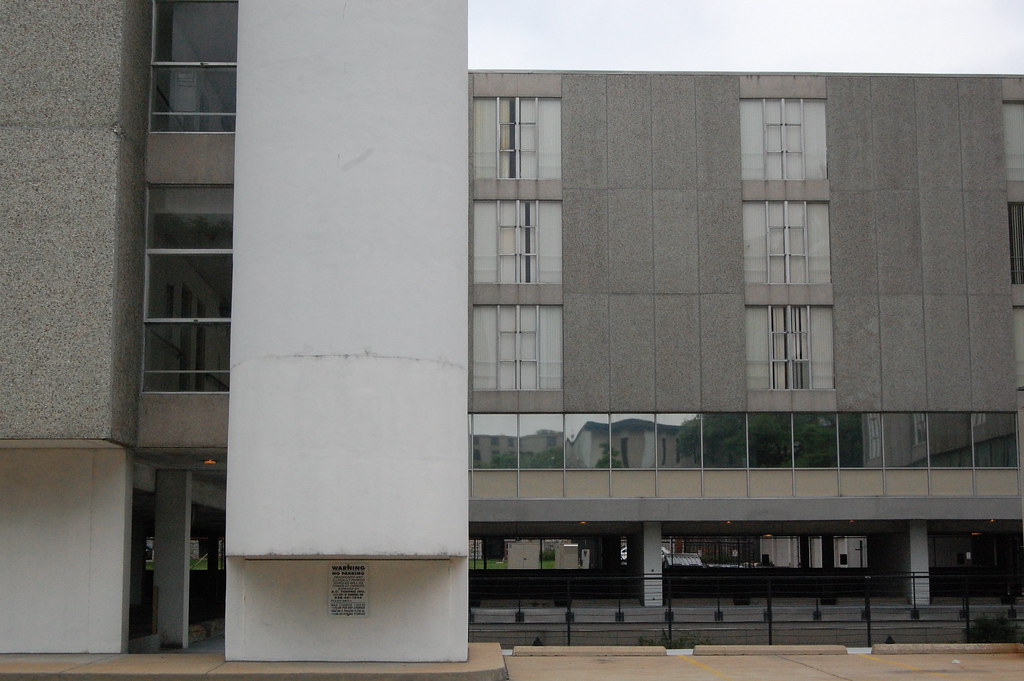 Demolition of the former DeVille Motor Hotel, 4483 Lindell Boulevard, will be on Monday’s Preservation Board agenda. Read more here.
Demolition of the former DeVille Motor Hotel, 4483 Lindell Boulevard, will be on Monday’s Preservation Board agenda. Read more here.
by Michael R. Allen
The first motel in Springfield, Illinois was the State House Inn at 101 E. Adams Street in the heart of downtown. Built in 1961 and designed by Henry Newhouse, the State House Inn is a contemporary of St. Louis’ threatened DeVille Motor Hotel.
However, the State House Inn is celebrated by its city and has received the benefit of a historically-sensitive renovation. In 2003, the motel reopened after a three-year, $8 million renovation. Today, the motel’s guests enjoy lovely modern lodgings just a short walk from Springfield’s major attractions as well as the Amtrak station.
Could the DeVille be the beneficiary of a similar renovation? While not downtown, the DeVille is a short walk from some of the city’s attractions — the Cathedral, Forest Park — and near light rail that connects to our Greyhound/Amtrak station. The Central West End stays open later than downtown Springfield, too, with many restaurants and bars within a short walk of the motel. With the same applied imagination that the State House Inn received, the DeVille could be one of St. Louis’ coolest places to stay.
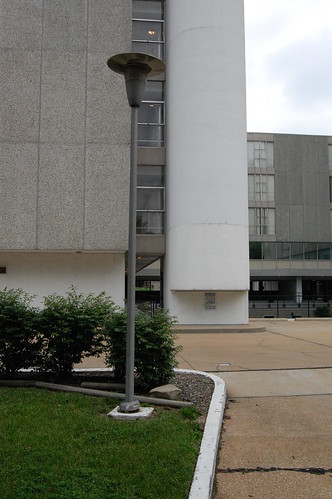 Demolition of the former DeVille Motor Hotel, 4483 Lindell Boulevard, will be on Monday’s Preservation Board agenda. Read more here.
Demolition of the former DeVille Motor Hotel, 4483 Lindell Boulevard, will be on Monday’s Preservation Board agenda. Read more here.
by Michael R. Allen
Graphic by Kara Clark Holland.
The day has arrived: On next Monday, June 22, the St. Louis Preservation Board will consider the demolition of the DeVille Motor Hotel (recently the San Luis Apartments) at 4483 Lindell Boulevard. The Archdiocese of St. Louis has asked the Board to conduct a preliminary review of its plan to demolish the mid-century motel and build a surface parking lot. As a preliminary review, the issue is not tied to an actual demolition permit. However, if the Board grants preliminary review, the city’s Cultural Resources Office must approve the demolition permit (after any stipulations placed on issuance have been met). If the preliminary review ends up with a denial, the Archdiocese will have to return to the Preservation Board with a new plan.
While some have said that this is a “done deal,” that is not true. The Preservation Board can block the demolition next Monday. However, your help is needed — the Board seeks direction not only from the applicant and preservation professionals, but from the wider public. Central West End residents especially should chime in.
I should also note that those who don’t particularly like the DeVille but loathe the urban design travesty of a surface lot on Lindell Boulevard will be best served by board denial of the current proposal. Once the parking lot is approved, the idea of a new building on the site is at the Archdiocese’s discretion. Don’t hold your breath.
Please send your written comments, no matter how brief, to the Preservation Board by submitting an e-mail to Board Secretary Adonna Buford at BufordA@stlouiscity.com. You might consider copying your letter to Alderwoman Lyda Krewson (D-28th), who represents the DeVille site and whose leadership on this matter would be helpful.
You can also send a letter via postal mail to:
Preservation Board
c/o Cultural Resources Office
1015 Locust Street, Suite 1200
St. Louis, MO 63101
If you would like to present your comments in person, the Preservation Board meeting is at 4:00 P.M. on the 22nd at 1015 Locust, Suite 1200. There are several items on the agenda before the San Luis, so the meeting may be long.
Everything you need to know about the issue is online at No Parking Lot on Lindell!.
by Michael R. Allen
 On May 1, the National Park Service listed a mid-century motel on Lindell Boulevard in the National Register of Historic Places. This recognition went not to the much-celebrated, threatened DeVille Motor Hotel, but to its predecessor one block west, the former Bel Air Motel at 4630 Lindell Boulevard.
On May 1, the National Park Service listed a mid-century motel on Lindell Boulevard in the National Register of Historic Places. This recognition went not to the much-celebrated, threatened DeVille Motor Hotel, but to its predecessor one block west, the former Bel Air Motel at 4630 Lindell Boulevard.
Along with the National Register listing, the Bel Air has received a $9 million renovation by the Roberts Companies and rebranding as the Hotel Indigo. Although not yet open, the spiffed-up modern motel has attracted a lot of positive attention. Central West End residents can’t believe their eyes when they look at what was recently a run-down Best Western. Others have taken notice, too: last month, Landmarks Association of St. Louis bestowed upon the Roberts brothers one of the Most Enhanced Sites awards, further recognizing the mid-century renovation.
The motel’s streamline frame has been cleaned and repainted a crisp white (the previous colors were black and pink), the obnoxious canopy rebuilt in a manner sympathetic with the motel’s design and the interior updated. All in all, the Hotel Indigo is a shining, clean, cool testament to the power of imagination and rehabilitation. The place hasn’t looked this great since opening day in 1958!
That opening day was a big event itself, since the Bel Air was the city’s first motel. The motel (short for “motor hotel”) style of lodging dated back to California in 1925. Motels before World War II tended to be “motor courts” like the celebrated Coral Court where rooms had separate exterior entrances and often private garages facing out on a court or central driveway. In St. Louis, a few of these courts were built in St. Louis County and in Illinois on Route 66. The city had its large, fine hotels with lodging, dinner and dancing all under one roof.
Developer Norman K. Probstein thought that the modern motel and the city hotel could be melded into a form new to St. Louis, the urban motel or motor lodge. In 1957, Probstein hired Wilburn McCormack to design a two-story motel for a site on Lindell. construction was underway that year. McCormack’s design was spare and used the principles of the International style. Rooms were accessed both by interior hallway. Some rooms have balconies facing a courtyard. Parking was underneath the motel. There was an outside swimming pool and an inside restaurant, expanded later in 1961. After opening, the Bel Air had so much business that Probstein added a third floor (designed by Russell, Schwarz, Mullgardt & Van Hoefen) in 1959 to bring the motel to a grand total of 198 rooms. Later, Probstein opened a downtown Bel Air East at Fourth and Washington (now the Hampton Inn), and dubbed the original Bel Air the “Bel Air West.”
Here is what the Bel Air looked like in 1979, with the Doctors Building visible in the background:
Over the years, the motel’s luster was lost through changes in ownership, interior decoration and exterior painting and signage. The Bel Air lost more of its historic character than the DeVille Motor Hotel has, yet it retained more than enough beauty to attract the interest of a developer and get listed in the National Register of Historic Places. The Roberts Companies purchased the motel in 2007 and worked with Killeen Studio Architects to develop a thoughtful, respectful rehabilitation plan. Karen Bode Baxter, Tim Maloney and I wrote the National Register of Historic Places nomination.
The exterior is back to near-original condition, with a few changes like the glass block entrance. Inside, where fewer details remained, the style is more contemporary than retro but a few historic elements can be found. One of the coolest features is the etched brick wall in a third floor suite:

One of the fundamental elements of the design of the Bel Air is the contrast between the white-painted concrete piers and caps and the red brick. The rehabilitation revives this stark and magnetic element on all sides. Here’s a look at the rear courtyard:
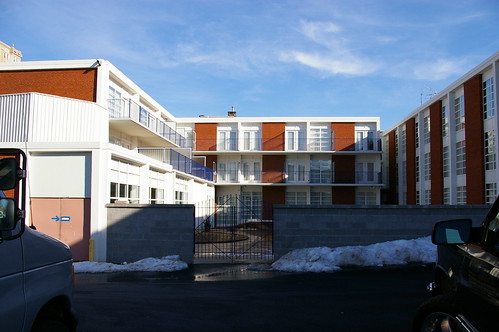 The renewed Bel Air Motel shows us that mid-century motels can be rehabilitated beautifully and that developers are interested in tackling these buildings. While many of the city’s modern motels are lost or reclad, those that are left could very well follow the path that the Roberts Companies has wonderfully shown us is possible.
The renewed Bel Air Motel shows us that mid-century motels can be rehabilitated beautifully and that developers are interested in tackling these buildings. While many of the city’s modern motels are lost or reclad, those that are left could very well follow the path that the Roberts Companies has wonderfully shown us is possible.
(Contemporary photographs courtesy of the Roberts Companies.)
by Michael R. Allen
In early March, I received a call from Jeff Vines. He was part of a team that entered a documentary film competition, and they had been fortunate enough to draw “history” for their topic. You know what that meant — a chance to celebrate the DeVille Motor Hotel! Jeff’s team included familiar faces — his brother Randy, filmmaker Carson Minow, editor Jon Swegle and musician Brian Wiegert. Toby Weiss and I were interview subjects for what turned out to be a smart, cool little film. Check it out!
Dead Zone
by Michael R. Allen
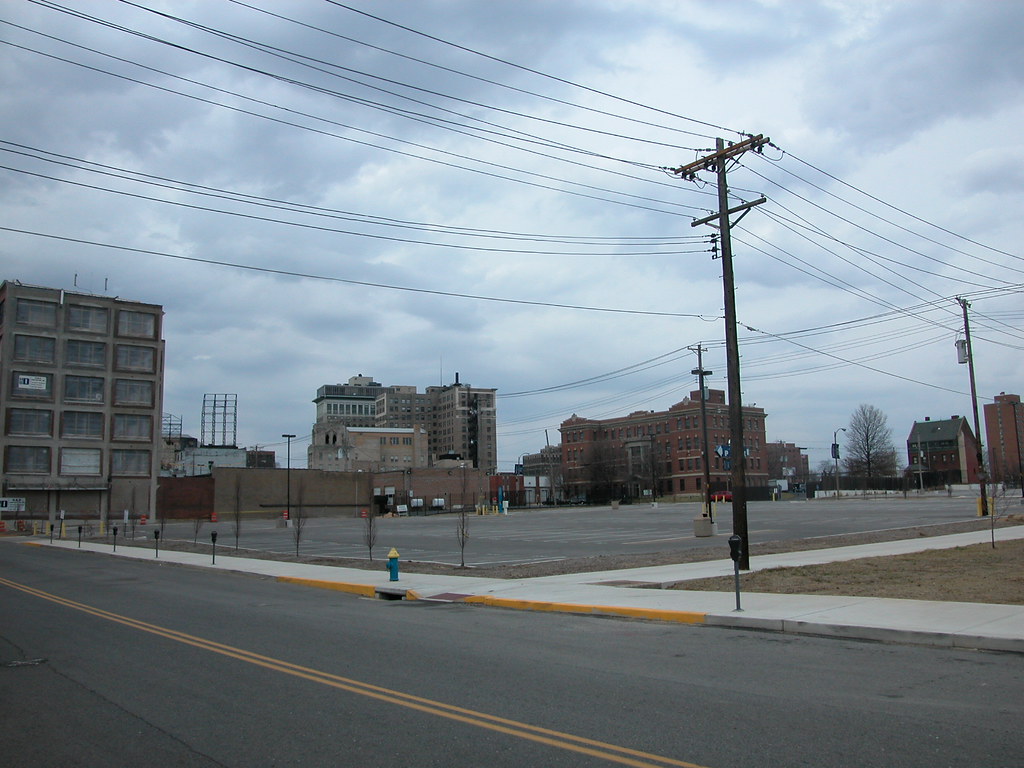 Over the weekend, I had the opportunity to spend some time at the site on Locust Street where the livery stable demolished by St. Louis University in 2007 once stood. The site would be located at the northwest corner of Locust and Josephine Baker Avenue, except that the university requested that Josephine Baker be removed.
Over the weekend, I had the opportunity to spend some time at the site on Locust Street where the livery stable demolished by St. Louis University in 2007 once stood. The site would be located at the northwest corner of Locust and Josephine Baker Avenue, except that the university requested that Josephine Baker be removed.
The occasion was the filming of This Was the Future, a short documentary on the efforts to save the DeVille Motor Hotel (more on that film later). For the film, interview subjects were invited to select a site where a historic building once stood that is now an empty hole in a vibrant area. While it is hard to choose from some of the harsh empty lots we have in this city, I settled on what has to be one of the worst urban planning disasters in recent years.
 The two-story livery stable building was a bridge between the emergent renewal in the Locust Street Business District and the more established revitalization of Grand Center. Grand Center’s motto is “the intersection of art and life,” an acknowledgment of the power of crossroads. Here stood a building that was a crossroads, and now we have an asphalt chasm, and not even a literal crossroads since one of the two streets here is now gone.
The two-story livery stable building was a bridge between the emergent renewal in the Locust Street Business District and the more established revitalization of Grand Center. Grand Center’s motto is “the intersection of art and life,” an acknowledgment of the power of crossroads. Here stood a building that was a crossroads, and now we have an asphalt chasm, and not even a literal crossroads since one of the two streets here is now gone.
Even as a warehouse, the livery stable exuded more life than the parking lot on a busy night. On a Saturday afternoon, not a single car was parked on the lot, and few were parked at nearby meters. Clearly, the lot is there for special events. However, trading the potential of daily urban activity in a rehabilitated building for the occasional overuse of a parking lot makes no sense in a central city location. Not at all.
The side effect of the livery stable debacle is the spatial segregation (through building density) of Grand Center from the emergent area on Locust and of Renaissance Place (through removal of Josephine Baker) from St. Louis University and Locust Street. Human-scale urban renewal has finally come to Midtown on Locust Street and at Renaissance Place, and a potential connection between those successes is lost, and replaced with a land use that not only divides but is totally alien to the surrounding urban fabric. We could have done so much better.


